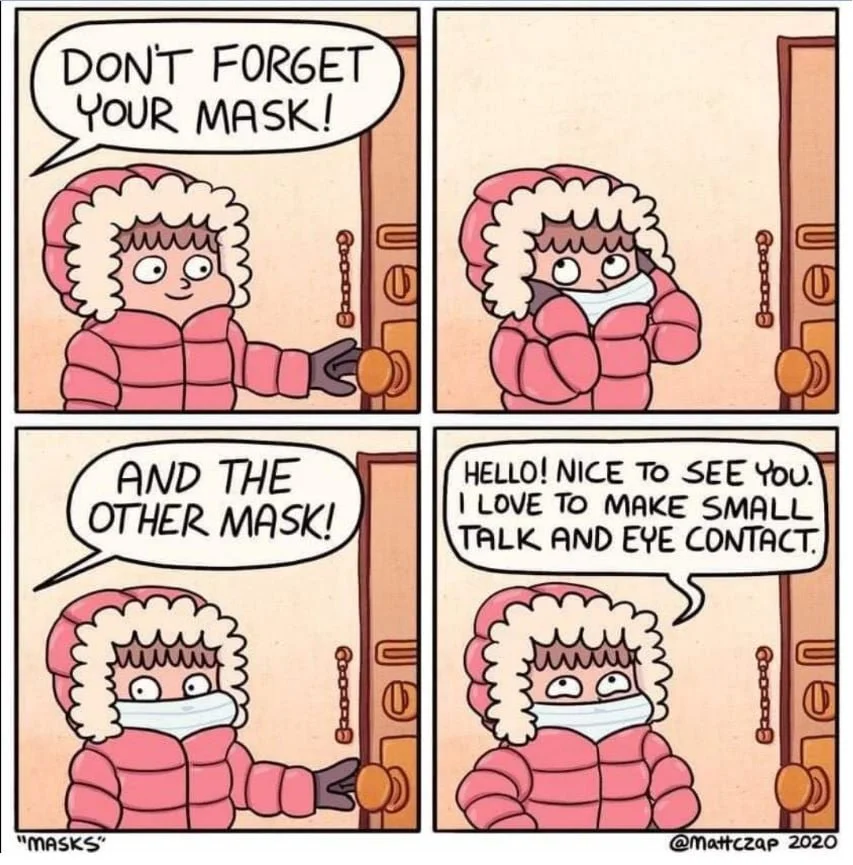On Autistic Masking
Comic by Matt Czap, 2020 https://mattczap.com/
As I posted earlier, autistic people can lie, but there are several reasons we usually avoid it if we can. First, most of us (although definitely not all of us) are bad at it. Second, it strikes many of us as a penny-wise, pound-foolish way to go through life, creating lies to cover up lies to cover up lies. We’re already using so many spoons just to function that maintaining a web of lies sounds like a full-time job. Third, we have been misunderstood our entire lives, so most of us desperately want to be understood and accepted exactly as we are. Against that backdrop, lying seems like self-sabotage. Nonetheless, there is a type of social performance that autistic people use as a coping mechanism. In the research literature it’s called masking or camouflaging.
Everyone masks to some extent. Politeness norms require us to inhibit thoughts and impulses that make other people uncomfortable. But autistic people must survive in environments that were not normed for us, so our social experiences are generally more demanding. For example, I came of age in the 1980s when the band The Cure was popular. (Does anybody not like “Just Like Heaven?”) I saw them in concert twice, both of which were torturous experiences. Live music is just too loud for me, and being immersed in a crowd was a tactile nightmare. But fear of missing out and a desire to build friendships had me climbing into the back of that van and heading to the Detroit Silverdome twice. I gritted my teeth through the evening and probably slept half the next day, but I was glad I went.
The difference between masking and lying is that masking is the suppression of reactions we know will make other people uncomfortable or demand too much of them. Masking is a type of care that we extend to others to preserve our relationships by being less “high-maintenance” to the people we value. Lying, in contrast, is about duping other people to maintain a personal advantage. Masking is generally prosocial, whereas lying is more likely to be antisocial. (Yes, I know that some people consider “white lies” to be prosocial, but not everyone agrees.) I know I am oversimplifying things with this dichotomy and that there are massive gray areas, but the point is that masking is typically done to connect with people, not exploit them.
Consider the case of someone with Tourette Syndrome suppressing the impulse to swear. They are trying to avoid offending people. Likewise, autistic people might suppress stims that are not socially acceptable, like hand flapping or echolalia. The problem is that it takes tremendous energy to mask, especially for long periods of time in environments that produce somatosensory dysregulation. You don’t need to attend a concert to witness such an environment; just visit your local elementary school.
Masking also includes the social approach captured in the idiom “When in Rome, do as the Romans do.” I grew up experimenting with this and observing where it succeeds and where it fails. With table manners, the marvelous food writer MFK Fisher advised watching one’s host and following suit. With more complex behaviors like “being professional,” it’s not so easy. We have to know which Romans to model. Early in my career, I shot myself in the foot more than once by modeling the wrong person. Once, in an academic job interview, I responded to a question with the same glib tone frequently used by a senior professor at my first job. The audience gasped. That’s when I realized that there are many Romes.
Masking appropriately for the Rome one happens to be visiting is necessary for social survival. Yet the lifetime costs of masking can be profound. My favorite Shel Silverstein poem, appropriately titled MASKS, sums it up parsimoniously:
She had blue skin
And so did he
He kept it hid
And so did she
They searched for blue
Their whole life through
Then passed right by–
And never knew
Our first Rome is our childhood home. Not all of us grew up in healthy, functional households. We may have masked from earliest childhood to placate our own parents. It can take years to find people who accept us as we are, quirks and all. But as Silverstein’s poem suggests, we have to be willing to shed the mask and expose those quirks if we want to identify the people who are equipped to understand us best.
Whether or not you’re neurodivergent, one way to improve your relationships with neurodivergent people of all kinds is to let them do whatever their bodies need to do to achieve a state of somatosensory regulation, and stop taking it personally when they do something outside the traditional (and sometimes extremely controlling) definition of politeness. (Consider “whole-body listening,” a highly demanding performance of semi-paralysis that is more about the speaker’s convenience than the listener’s learning.) A fidgeting child is not being disrespectful. Eye contact is not a sign of listening. Direct and honest communication may not feel as good as flattering lies, but if the communicator is telling you what you need to know, they are empowering you. We all need truthful people in our lives.
The upshot of accommodating neurodivergent people is that we will usually reciprocate by accommodating you in return, thus creating an environment where we can all take off our masks. This vision of social Nirvana may never be attainable in its purest form, but we have everything to gain, and nothing to lose, by working toward it.

